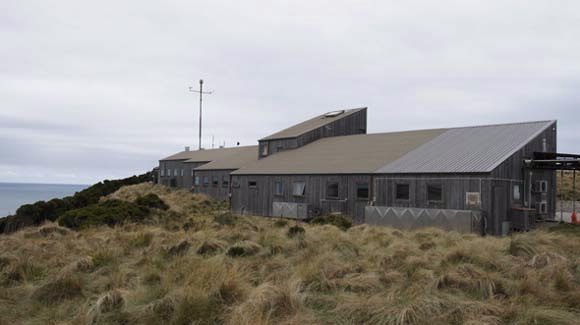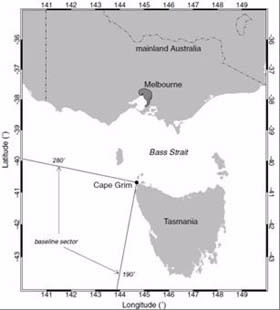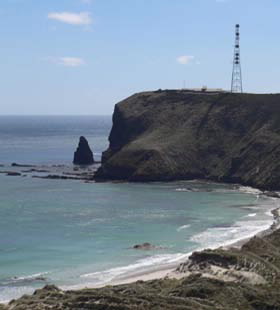ANSTO's radon measurements at Cape Grim in Southern Australia are contributing to a global effort to better understand the chemical makeup of our atmosphere and help protect our planet and its people.
 |
| Cape Grim |
It's common knowledge that significant changes to the make-up of our atmosphere - from both natural and human-induced activities - have had a devastating impact on our planet with even greater environmental, social and economic problems projected in coming decades.
Science is doing its part on a number of fronts, including a specialised agency of the United Nations that's providing an authoritative voice on the state and behaviour of the Earth's atmosphere with world class facilities like those run jointly by ANSTO, CSIRO and the Bureau of Meterology (BOM) in Cape Grim, Tasmania.
About Cape Grim
The Baseline Air Pollution Station at Cape Grim in Tasmania (Figs 1,2) is Australia’s contribution to international efforts for monitoring the global background atmosphere for trends due to human activities and natural variability.
As a premier station in the Global Atmosphere Watch (GAW) network of the World Meteorological Organization (WMO), Cape Grim contributes very significantly to the WMO-GAW program investigating the role of atmospheric chemistry in global change, assisting in the development of predictive capabilities for future atmospheric states and feeding into global environmental policy development.
Research outputs from Cape Grim are published in peer-reviewed journals of the highest quality, are very frequently cited, and feed into the global assessments.
The Australian Bureau of Meteorology (BoM) and CSIRO Marine and Atmospheric Research (CMAR) jointly oversee the Cape Grim Science Program, and co-invest with other contributing organisations including ANSTO to provide and maintain an effective and innovative observational program in global atmospheric composition.
 |
| Figure 1. The Cape Grim Baseline Air Pollution Station (CGBAPS) in Northwest Tasmania |
 |  |
| Figure 2. Geographical location of CGBAPS |
ANSTO radon measurements at Cape Grim
Radon-222 (radon) is a naturally occurring radioactive noble gas of predominantly terrestrial origin, commonly used for atmospheric tracer studies.
As radon is an unambiguous indicator of recent terrestrial influences on an air mass, radon measurements form a core component of the observational program at all WMO-GAW sites monitoring changes in global atmospheric composition and climate.
ANSTO’s radon program at the Cape Grim Baseline Air Pollution Station (CGBAPS) began in 1980 and has produced continuous data since 1983.
The aim of the Cape Grim Radon Program is to produce and apply high quality radon observations to advance our understanding of global atmospheric composition, pollution and climate. Specific goals of the program are to:
- lead measurements of continuous, high temporal resolution (hourly), high sensitivity (≤10 mBq m-3 lower limit of detection) time series of atmospheric radon concentrations;
- maintain and strengthen the world-leading expertise in measurement techniques of very low radon concentrations in marine air least perturbed by recent land contact;
- further refine fetch analysis to exploit the CGBAPS’ unique location for probing a large area of the Southern Ocean and mainland Australia south of 28 ºS;
- exploit the potential that radon offers for: (a) calibrating and/or constraining regional terrestrial emissions of greenhouse gases including carbon dioxide, methane, nitrous oxide, molecular hydrogen and other gases; and (b) evaluation of transport and mixing schemes in weather, climate and chemistry transport models on various scales;
- expand measuring programs of atmospheric radioactive species at locations of national / international importance with strong links to the CGBAPS program; and
- further strengthen the CGBAPS role within the WMO-GAW community.
At Cape Grim, changes in atmospheric radon concentrations are measured to high precision and temporal resolution using purpose-built high sensitivity instruments (Fig. 3).
The collaboration between ANSTO and the Cape Grim community, as well as the unique facilities provided at CGBAPS, has enabled a continuous process of radon instrumentation development over the years.
These efforts have led to an ongoing recognition within WMO-GAW and the international scientific community that ANSTO radon detection systems are the best in the world for global and regional atmospheric composition studies.
 |
Figure 3. Current 5000L primary radon detector HURD-3 (foreground) and 1500L backup detector BHURD-2 (left background) at CGBAPS. In the pump enclosure (right), the common airstream from the tower inlet at 70m is split and “pushed” towards the two detectors at 300L/min and 100L/min, respectively. This insures that the detector tanks and the near-ground inlet lines operate at a slight over pressure to minimize contamination by small leaks. |
Achievements of the Cape Grim Radon Program
Outcomes from the ANSTO radon program at Cape Grim can be summarised as follows:
- High quality radon measurements in support of the Cape Grim observational program monitoring changes in global atmospheric composition and climate. The radon program has consistently provided continuous quality-controlled hourly time series of atmospheric radon concentrations and derivative products to the broader Cape Grim scientific community and overseas researchers. Over the years, these data sets have been used for a range of research applications aligned with the goals of the Cape Grim science program.
- Development of instrumentation for measurement of very low radon concentrations in marine air. Throughout its history, the Cape Grim radon program has been notable for its active and productive program developing high sensitivity low limit of detection monitors for very low radon concentrations in marine air least perturbed by recent land contact. These efforts have led to an ongoing recognition within the international scientific community that ANSTO radon detection systems are the best in the world for global and regional atmospheric composition studies.
- Atmospheric composition, climate and pollution research studies using Cape Grim radon data. Cape Grim radon measurements have been used in a wide variety of collaborative research studies, and the results have been disseminated via research papers and reports, as well as presentations at national and international conferences. Research topics for these publications can be grouped into the following broad categories:
- Summaries / reviews of radon measurements and their applications
- Radon instrumentation papers
- Selection of least (terrestrially) perturbed marine air masses for baseline studies
- Tracing of air mass origins and movements (history and fetch)
- Global / regional radon concentration and flux distributions over land and ocean
- Distribution and sources of pollutants (calibration / constraint of regionally-integrated emission estimates for important distributed trace gases)
- Model evaluations (performance of climate, weather and chemical transport models on global and regional scales)
Other achievements:
- Further strengthening of the ANSTO role within the WMO-GAW community, through major contributions by the radon group to WMO-GAW and IAEA specialist meetings
- ANSTO participation in radon programs at other locations with important strategic and scientific links to the CGBAPS program. This includes radon measurements at other sites in the WMO-GAW network (Hawaii, South Africa, Switzerland and Antarctica), as well as our recently-developed “Southern Ocean Region Radon Network” (Cape Grim, Macquarie Island, South Africa, Antarctic Peninsula and the new Australian National Marine Facility RV Investigator) which represents a unique tracer facility for aiding the characterisation of sources and movement of atmospheric pollutants in the extended fetch of Cape Grim
About ANSTO's atmospheric radioactivity group
Results from the group's research are aimed at enabling practical, science-based improvements to the management of pollution.
Published: 16/12/2013


